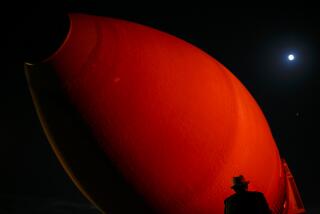Physics blogs hint that long-sought Higgs boson is in sight [Updated June 21]
Physicists working at the Large Hadron Collider on the border of France and Switzerland may be on the verge of announcing the discovery of the long-sought Higgs boson, the so-called God particle that theorists believe gives all other particles mass. Physics bloggers are atwitter -- figuratively and literally -- with speculation that the discovery will be announced at the upcoming International Conference on High Energy Physics to be held in Melbourne, Australia, beginning July 4. If the speculation is true, the announcement would have to be considered one of the greatest physics feats of the last half century.
The Higgs boson, named after physicist Peter Higgs of the University of Edinburgh, is a key component of the so-called Standard Model, which theorists developed early in the 20th century to understand the basic functioning of our universe. Higgs and others suggested that the universe is pervaded by an invisible, massless substance that behaves like a cosmic molasses. Particles passing through it collect small bits of the molasses to acquire weight. Without it, there would be no mass to hold the universe together. Higgs proposed that the right kind of high energy collision of certain elementary particles could yield a representative of this molasses, which came to be known as the Higgs boson.
But producing such collisions is extremely difficult. The Tevatron, a 4-mile-long accelerator at the Fermi National Accelerator Laboratory in Batavia, Ill., produced some hints that the Higgs might exist, but the collisions it could produce were right on the border of the energy required. The U.S. shut down the Tevatron last year. A proposal to construct the Superconducting Super Collider, which would have been a 54-mile-long ring near Waxahachie, Texas, was canceled in 1993 because of cost overruns.
In an effort to find the Higgs, a consortium of some 20 European nations constructed the Large Hadron Collider at the European Organization for Nuclear Research, commonly known as CERN. That $11.5-billion project involved construction of a 17-mile-long ring in which particles are accelerated to speeds very near the speed of light and crashed into one another, yielding a plethora of smaller particles and, hopefully, eventually, ultimately, the Higgs boson.
Two large teams of researchers are now analyzing data from more than a year of such collisions. A report last fall suggested that one team had seen traces of what might be the Higgs with a mass of 126 gigaelectronvolts (GeV), which would be in the right range. In contrast, a proton has a mass of 1 Gev, while an electron has a mass of only 500,000 electronvolts. But their findings had a so-called three-sigma confidence: that is, there remained an 0.13% possibility that the results happened by chance. Physicists generally require a five-sigma reliability, meaning a 0.000028% possibility that the results are due to chance, before announcing a “discovery.”
[Updated June 21: The original version incorrectly stated that a three-sigma confidence gives a 13% possibilility that the results occurred by chance. The correct possibility is 0.13%.]
A second team obtained results suggesting the Higgs has a mass of 124 GeV, again with about a three-sigma reliability. The teams are now said to be working feverishly to refine and reconcile those results before the July 4 meeting and the outside world is waiting expectantly. But a spokesman for one of the teams, Fabiola Gianotti, said in an email to the New York Times, “Please do not believe the blogs.”
In any case, it is only two more weeks until the meeting, at which time the veil of secrecy, one hopes, will be lifted.
LATimesScience@gmail.com
Twitter/@LATMaugh






